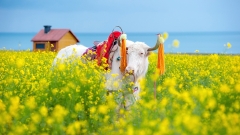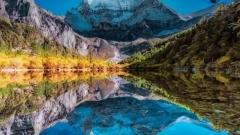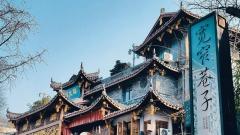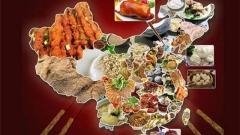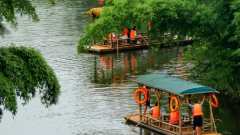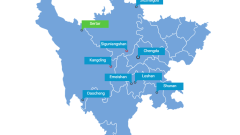Winter in Western Sichuan transforms the region into a wonderland of snow-capped peaks, frozen lakes, and quiet Tibetan villages. For travelers who love the freedom of the open road, this is the perfect time to experience China’s most scenic highland drives—routes that weave through majestic mountain passes, ancient monasteries, and pristine valleys. Whether you’re chasing sunlight over Mount Gongga or exploring the snowy grasslands of Tagong, Western Sichuan’s winter roads promise breathtaking beauty at every turn.
Why Drive in Western Sichuan During Winter?
Many travelers visit Western Sichuan in spring or autumn, but winter offers something truly special. The crowds are gone, accommodation prices drop, and the landscapes—dusted with snow and kissed by clear blue skies—feel pure and untouched.
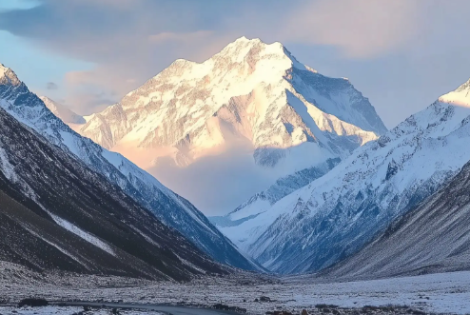
Unlike much of northern China, Western Sichuan remains accessible in winter thanks to well-maintained roads. On sunny days, visibility is crystal clear, offering stunning views of the Tibetan Plateau’s white peaks. The air is crisp, photography conditions are perfect, and every small village feels calm and authentic.
Essential Tips for Winter Road Trips
Before we explore the routes, here are a few key travel tips:
-
Vehicle: Choose a 4WD SUV with good snow tires and heating.
-
Driving Permits: Foreign travelers must hire a driver or join a local tour company such as China Dragon Travel; self-driving is not permitted without special arrangements.
-
Fuel & Food: Fill your tank often and carry snacks—gas stations and restaurants can be sparse in remote areas.
-
Weather & Altitude: Be prepared for temperatures below -10°C and occasional icy roads. Always bring warm layers and oxygen supplies for high-altitude sections.
The Most Scenic Winter Drives in Western Sichuan
Route 1: Chengdu → Kangding → Tagong → Xinduqiao → Yajiang
Distance: ~450 km
Highlights: Snow mountains, Tibetan culture, photography
This is the classic gateway route into the Kham Tibetan region, and in winter it’s even more stunning. After leaving Chengdu, you’ll ascend into the mountains, crossing Erlang Tunnel before reaching Kangding—a vibrant town where Tibetan and Han cultures meet.
Continue to Tagong, known as the “Little Tibet of Sichuan.” The Tagong Grasslands sparkle under snow, and the Tagong Monastery stands proudly against the white peaks. Don’t miss Mount Yala (5820m)—its pyramid shape is breathtaking in the morning light.
Then, drive toward Xinduqiao, a paradise for photographers nicknamed the “Town of Light and Shadow.” Winter sunlight reflecting off wooden houses and frozen rivers creates postcard-perfect scenes. End in Yajiang, a peaceful highland town surrounded by mountains.
Route 2: Chengdu → Luding → Moxi → Hailuogou Glacier Park
Distance: ~350 km
Highlights: Glacier scenery, hot springs, Mount Gongga
If you’re short on time but want incredible variety, this route is ideal. Hailuogou Glacier Park at the foot of Mount Gongga (7,556m) offers a rare chance to see glaciers up close in China. In winter, the forests are covered in frost, and the massive blue ice tongues look otherworldly.
After a day of exploration, soak in Hailuogou Hot Springs, where you can relax under a canopy of steam and snowflakes. The drive from Chengdu to Moxi passes through deep valleys and small Tibetan villages—perfect for a quiet winter escape.
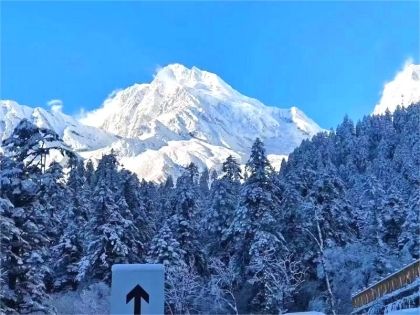
Winter Hailuogou
Tip: Stay overnight in Moxi Town for easier park access and warm local meals.
Route 3: Chengdu → Danba → Bamei → Tagong → Kangding
Distance: ~560 km (loop route)
Highlights: Tibetan villages, snow-capped valleys, ancient watchtowers
This circular route combines cultural discovery with alpine beauty. Begin in Danba, famous for its ancient stone watchtowers and the beautiful Jiaju Tibetan Village. In winter, these villages resemble scenes from a fairy tale—wooden homes blanketed in snow, with smoke curling gently from chimneys.
Drive toward Bamei, where the Yala Snow Mountain dominates the horizon. Between Bamei and Tagong, you’ll cross open grasslands, often dotted with grazing yaks and prayer flags fluttering in the icy wind. The golden sunlight against the snow creates spectacular photo opportunities.
Route 4: Kangding → Litang → Daocheng → Yading Nature Reserve
Distance: ~720 km
Highlights: High plateau landscapes, sacred mountains, pristine lakes
For adventurous travelers, this is Western Sichuan’s ultimate winter drive. The road from Kangding to Daocheng passes through mountain passes over 4,700 meters high, including the Haizi Mountain Plateau, which glitters under snow.
Yading Nature Reserve, known as “the last pure land on Earth,” remains open in winter (except during heavy snow). Though colder, it’s peaceful and uncrowded, offering incredible views of the three sacred peaks—Chenrezig, Jampelyang, and Chanadorje.
The turquoise lakes of Yading freeze into surreal patterns, and with no crowds, you can truly absorb the silence of this spiritual place.
Route 5: Chengdu → Barkam → Hongyuan → Ruo’ergai Grassland
Distance: ~600 km
Highlights: Vast snowfields, frozen wetlands, nomadic culture
This northern route offers a completely different kind of beauty. The Ruo’ergai Grassland, near the border of Sichuan and Gansu, is one of China’s largest wetlands. In winter, it becomes a vast frozen plain where the horizon seems endless.
The First Bend of the Yellow River and Huahu Lake (Flower Lake) are magnificent when frozen, reflecting pink and gold hues at sunrise. Along the way, you’ll see Tibetan herders tending yaks and horses wrapped in colorful blankets—a timeless scene that feels worlds away from modern China.
Accommodation and Food Along the Way
Even in winter, most major towns along these routes—Kangding, Tagong, Danba, Daocheng, and Yajiang—have comfortable guesthouses and boutique lodges. Some offer heated beds, electric blankets, and Tibetan-style fireplaces.
Local cuisine is hearty and perfect for cold days:
-
Butter tea to warm up at high altitudes
-
Tibetan noodles and yak soup for a quick meal
-
Hotpot and barbecue available in larger towns like Kangding and Danba
For a memorable experience, try homestay-style guesthouses where you can chat with locals around the stove and learn about highland traditions.
Photography and Sightseeing Tips
-
Timing: Early morning and sunset offer the best lighting for snow mountains.
-
Gear: Bring ND filters, spare batteries (cold drains them fast), and a drone if allowed.
-
Etiquette: Always ask before photographing people or monasteries.
-
Safety: Check local weather updates and road conditions—sudden snowfalls can close high passes.
Sustainable and Respectful Travel
Western Sichuan is home to fragile ecosystems and deeply spiritual communities. As you travel, remember to:
-
Stay on designated roads and avoid littering.
-
Support local businesses—eat at family-run restaurants, buy crafts directly from artisans.
-
Respect religious sites and avoid loud noise near monasteries.
-
Follow “Leave No Trace” principles, especially in protected areas like Yading and Hailuogou.
Traveling with a responsible operator like China Dragon Travel ensures safe driving, local guides, and authentic cultural interactions that benefit the communities you visit.
Conclusion
Winter drives in Western Sichuan offer some of the most dramatic scenery in all of China—majestic peaks, frozen lakes, quiet monasteries, and endless grasslands. It’s a season of purity and peace, when nature reveals its raw beauty and the plateau feels timeless. Whether you take a short trip to Hailuogou or venture deep toward Yading, each route offers a new perspective on the spirit of the Tibetan highlands.
So buckle up, prepare your camera, and let the snowy roads of Western Sichuan lead you into a breathtaking winter adventure.




